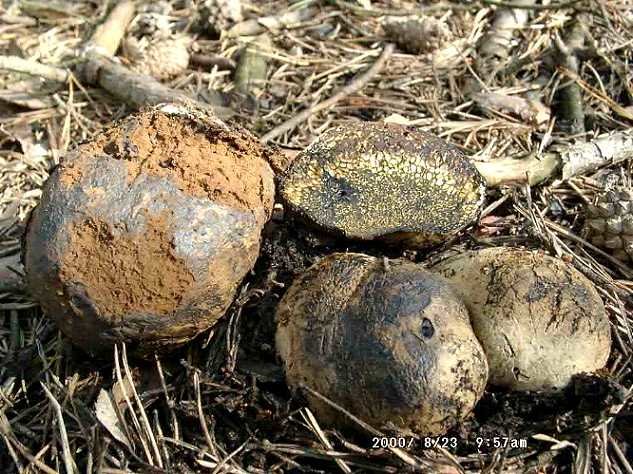Pisolitus rootless (Pisolithus arhizus)
- Division: Basidiomycota (Basidiomycetes)
- Subdivision: Agaricomycotina (Agaricomycetes)
- Class: Agaricomycetes (Agaricomycetes)
- Subclass: Agaricomycetidae (Agaricomycetes)
- Order: Boletales (Boletales)
- Family: Sclerodermataceae
- Genus: Pisolithus (Pisolithus)
- Type: Pisolithus arhizus (Pisolithus rootless)

fruit bodies:
pear-shaped or club-shaped, rounded at the top or having an irregularly spherical shape. Fruiting bodies elongated, pitted, branched at the base of a false leg or sessile. The thickness of the false leg is from 1 to 8 centimeters, most of the leg is hidden underground. The spore-bearing part in diameter reaches 2-11 centimeters.
Peridium:
smooth, thin, usually uneven, tuberculate. Brittle buffy yellow when young, becoming yellow-brown, red-olive or dark brown.
Soil:
Gleba of a young mushroom contains a large number of whitish capsules with spores, which are immersed in trama – a gelatinous mass. At the cut site, the fruiting body has a granular beautiful structure. Mushroom ripening starts from its upper part and gradually ends at its base.
As the fungus matures, the gleba breaks up into several uneven, pea-like peridioles. Angular peridioles, first sulphur-yellow, then reddish-brown or brown. A ripe mushroom takes on a resemblance to animal excrement, rotten stumps or half-rotten roots. Destroyed peridioles form a dusty powdery spore mass. Young fruiting bodies have a slight mushroom smell. Ripe mushrooms have an unpleasant smell.
Spore Powder:
brown.

Spread:
Pisolitus Rootless occurs on drained, disturbed or acidic soils. Grows in small groups or singly. Prefers mine ovals, planted old quarries, overgrown clearings of old roads and paths. Tolerant of very acidic soils and soils containing heavy metal salts. It bears fruit from summer to early autumn.
Edibility:
Some sources call the mushroom edible at a young age, others do not recommend eating it. Some reference books indicate the use of the mushroom as a condiment.
Similarity:
At a young age, this species can be mistaken for the Warty Puffball.









